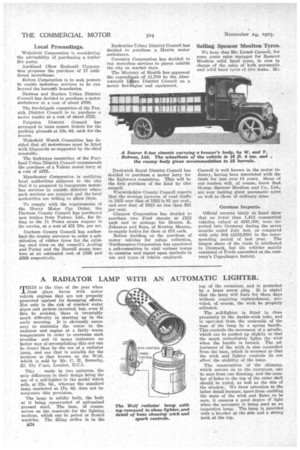A RADIATOR LAMP
Page 8

If you've noticed an error in this article please click here to report it so we can fix it.
WITH AN AUTOMATIC LIGHTER.
mIIIS is the time of the year when frost plays havoc with motor vehicle engines that are not properly protected against its damaging effects. Not only is the risk of cracked water pipes and jackets incurred, but, even if this be avoided, there is invariably much difficulty in starting up in the early morning. It is obviously necessary to maintain the water in the radiator and engine at a fairly warm temperature in order to overcome such troubles and in many instances no better way of accomplishing this end can be found than by the use of a radiator lamp, and one that is suitable for the purpose is that known as the Wolf, which is sold by Ur. C. H. Sowerby, 22, Ely P ace, London, E.C.1.
This • made in two patterns, the only difference in their design being the use of a self-lighter in the model which sells at 22s. 6d., whereas the standard lamp marketed at 17s. 6d. does not incorporate this provision.
The lamp is solidly built, the body of it being constructed of galvanized pressed steel. The base, of course, serves as the reservoir for the lighting medium, which can be petrol or Scotch naphtha. The filling orifice is in. the
B24 top of the container, and is protected by a brass screw plug. It is stated that the lamp will burn for three days without requiring replenishment, provided, of course, the wick be properly adjusted.
The scif-lighter is fitted in close proximity to the double-wick tube, and is operated from the underside of the base of the lamp by a spring handle. This controls the movement of a spindle, which can be pushed up slightly so that the spark immediately lights the wick when the handle is turned. The adjustment of the wick is also controlled from the base, _which is recessed so that the wick and lighter controls do not affect the stability of the lamp.
The construction of the chimney, which screws on to the container, can be seen from our drawing, and the number of holes in the top of the outer shell should be noted, as well as the size of the window. We draw attention to the latter detail because, apart from enabling the state of the wick and flame to be seen, it ensures a good degree of light when the accessory is being used as an inspection lamp. The lamp is provided with a bracket at the side and a strong hook at the top.




































